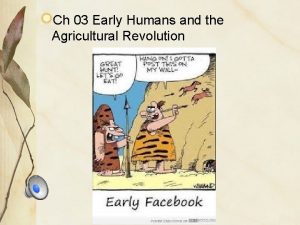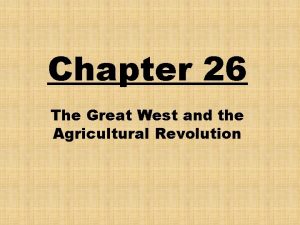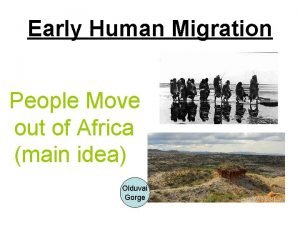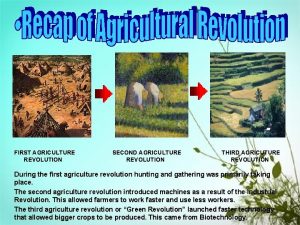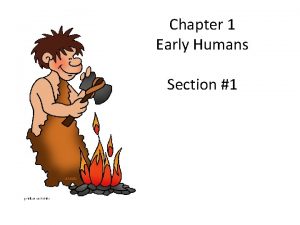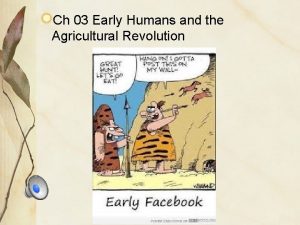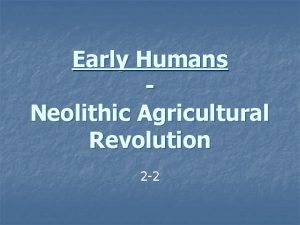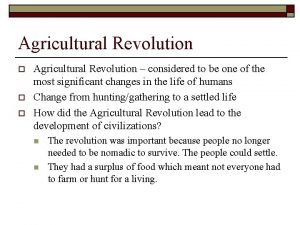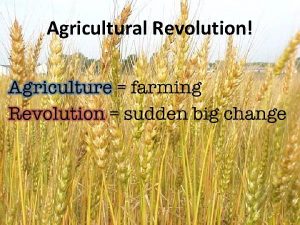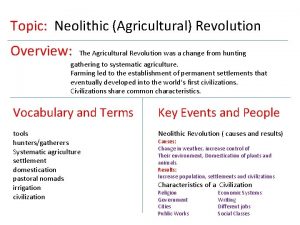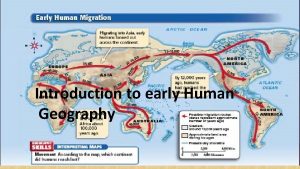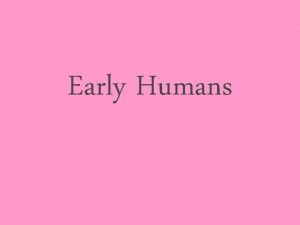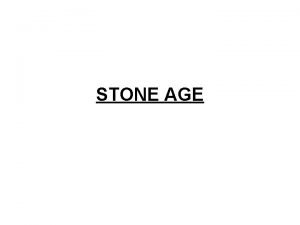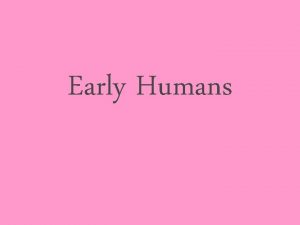Chapter 3 Early Humans and The Agricultural Revolution
































- Slides: 32

Chapter 3: Early Humans and The Agricultural Revolution Time: 8000 B. C. to 2000 B. C.

Lesson 1: Hunter- Gatherers

The Paleolithic Age Historians call the early period of human history The Stone Age. This was the time when people used stone to make tools and weapons. The earliest part of The Stone Age is called The Paleolithic Age. In Greek, Paleolithic means “old stone. ” This is why the Paleolithic Age is also called the Old Stone Age. Began about 2. 5 million years ago and last until around 8000 B. C.

Surviving in the Paleolithic Age Paleolithic people often moved around in search for foods. They were nomads, or people who regularly move from place to survive. Paleolithic people survived by hunting and gathering. They hunted buffalo, bison, wild goats, reindeer. If they lived along coastal areas they fished. They also gathered berries, wild nuts, fruits, wild grains, and plants.

Finding Food Men: Hunted large animals They had to learn how animals behaved and how to hunt them. These people developed tools and weapons to help them hunt. Women: Looked after the children and searched nearby woods and meadows for berries, nuts, and grains. v Everyone worked to find food because it was the key to the group's survival.

The Invention of Tools Over time, Paleolithic people made better, more complex tools. At first, they would use sticks, stones, and tree branches. Flint technology was a major breakthrough for these early peoples. They would hit flint with another hard stone, the flint would flake into pieces. These pieces had very sharp edges that could be used for cutting

Changing to Survive Climate affected how Paleolithic people lived. Some people lived in cold climates and made clothing from animal skins to stay warm. People constructed tents and huts of animal skin. People living in warmer climates needed little clothing or shelter. Many lived in caves and huts These shelters provided protection against attacks by large animals.

Fire Sparks Changes Life became less difficult for Paleolithic people once they discovered how to make fire. Provided warmth. Provided Light. Scared To away animals. cook.

Fire Sparks Change How did people learn to use fire? Archeologist believe early humans produced fire by friction. They learned that by rubbing two pieces of wood together, when the pieces because hot enough it would catch fire. They also discovered that a certain stone, iron pyrite, gave off sparks when struck against another rock. The spark could then ignite dry grass or leaves, which was another way to start fire.

Language One important advancement was the development of spoken language. Up until this time, early people communicated through sounds and physical gestures. Then they began to develop language.

Art Early people also expressed themselves through art. In 1879, a young girl named Maria de Sautuola wandered into a cave on her grandfathers farm near Altamira, Spain. She was startled by what she discovered on the walls of that cave. Paleolithic paintings have been found all over the world. They used crushed yellow, black, and red rocks and combined the, with animal fat to make their paintings. Early people created scenes of lions, oxen, panthers, and other animals. Few humans appeared on these paintings.

Questions…… Why was fire important for Paleolithic people? What subjects were most common in cave paintings?

The Ice Ages The Ice ages were major environmental disturbances. The changes they brought about threated the very survival of humans.

What changes came with the Ice Age? The Ice Ages were long periods of extreme cold that affected all of the Earth. Glaciers covered most of the land. The glaciers grew larger and the levels of the oceans water were lowered. The low sea levels exposed a strip of dry land connecting the continents of Asia and North America. The strip of land acted as a land bridge and as a highway that allowed people to travel from Asia into North America. The Paleolithic people would then move southward to settle in different regions. (parts of North America and South America)

How did the Ice Ages Affect Humans? Ice Age conditions posed a grave threat to human life. They had to adapt their diets by enriching their meals with more fat (more protein) They also learned to make sturdier shelters and make warm clothing using` animal fur. The Ice Age last about 90, 000 years.

Lesson 2 – The Agricultural Revolution

Neolithic Times After the Ice Age ended, Earth’s temperatures rose. As the climate warmed, many nomads moved into areas with mild climate and fertile land. For the first time, people began staying in one place to grow grains and vegetables. Farming began replacing hunting and gathering as the main source of food. People began to domesticate animals. Animals transported goods and provided meat, milk, and wool.

The Neolithic Age The change in the way people lived marked the beginning of the Neolithic Age. Humans went from being nomadic and hunters to settling in one place and learning how to grow crops. Began about 8, 000 B. C. and lasted until around 4, 000 B. C. The word Neolithic is Greek for “New Stone”

Big Change for Humankind Historians call this settled farming during the Neolithic Age the Agricultural Revolution. Humans lived differently once they learned how to grow crops and tame animals that produced food. This allowed the population to grow at a faster rate. Some historians consider the Agricultural Revolution the most important event in humans history.

Widespread Farming Southwest Asia • Grew wheat and barley. • Domesticated pigs, cows, goats, and sheep. Africa • Grew wheat and barley, yam, and bananas. Northern China • Grew a grain called millet and rice • Domesticated dogs and pigs. Mexico & Central America • Grew corn, squash, and potatoes. • Domesticated chickens and dogs.

Neolithic Communities Neolithic people built permanent homes near fields so people could plant crops and they also settled near water sources, especially rivers. Neolithic villages developed throughout Europe, India, Egypt, China, and Mexico.

Neolithic Communities One of the most famous Neolithic communities was Catalhuyuk in present day Turkey. These people had houses that did not have front door. People entered their homes through holes in the rooftops. They also had special buildings that were shrines. These shrines were decorated with images of gods and goddesses.

What were the benefits of a settled life? A settled life created greater security. Population increased. Villagers produced more than they could eat, so they began to trade their food for supply they could not produce themselves. Specialization occurred for the first time and people took up specific jobs as their talents allowed. Making weapons, jewelry, pottery.

What were the benefits of a settled life? The roles of men and women changed when people moved into settlements. They gradually became more responsible for growing food and protecting the village. Men emerged as family community leaders and women bore children and stayed at home. Women also wove cloth from wool to make clothing.

The End of the Neolithic Age During the late Neolithic Age, people made more technological advances. Hoes were invented for digging soil. Sickles for cutting grain. Millstones for grinding flour. People also began to work with metals like copper. They used copper to make tools and weapons. They also discovered that mixing copper and tin formed bronze.

The Bronze Age The discovery of Bronze, marked the beginning of the Bronze Age. The Bronze Age lasted from 3, 000 B. C. – 1, 200 B. C.

Civilizations Emerge (The Bronze Age) By the beginning of the Bronze Age communities were widespread. Complex cultures called civilizations began to develop. Four civilizations emerged around 3, 000 B. C. Mesopotamia Egypt India China ALL Civilizations share similar characteristics.

Cities & Government One characteristic of these early civilizations was that they developed cities and forms government. The first civilizations developed in river valleys. Fertile land made it easy to grow crops and it also provided fish and water. People formed governments to protect themselves and their food supplies. In these civilizations, the first form of government were monarchies.

Religions emerged in the new civilizations to help people explain their lives. Religions helped explain the forces of nature and the role of humans in the world. Rulers also claimed that their own power was based on the approval of the gods.

Social Structure Early civilizations had social class structures. People in society were organized into groups. Generally, rulers and priests, government officials, and warriors made up the highest social class. Below this class was a large group of free people, including farmers, artisans, and craftspeople. At the bottom of the class structure were enslaved people, most of whom were captured from enemies during the war.

Writing To pass on information, people invented ways of writing. They used symbols in place of letters and words. People used writing to keep accurate records and to preserve stories.

Art Civilizations also created art for enjoyment. Artists created paintings and sculptures portraying gods and forces of nature. People also designed massive buildings that served as places of worship or burial tombs for kings.
 Early humans and the agricultural revolution
Early humans and the agricultural revolution Early humans and the agricultural revolution answer key
Early humans and the agricultural revolution answer key Third agricultural revolution definition
Third agricultural revolution definition Chapter 26 the great west and the agricultural revolution
Chapter 26 the great west and the agricultural revolution Lesson 1 early humans
Lesson 1 early humans The rise of civilization lesson 2 the neolithic revolution
The rise of civilization lesson 2 the neolithic revolution Cause and effect neolithic revolution
Cause and effect neolithic revolution The great west and the agricultural revolution
The great west and the agricultural revolution About early humans for class 6
About early humans for class 6 Http //early humans.mrdonn.org/tools.html
Http //early humans.mrdonn.org/tools.html Lesson 1 early humans
Lesson 1 early humans Human migration out of africa
Human migration out of africa The agricultural revolution
The agricultural revolution Agricultural revolution inventions
Agricultural revolution inventions First agricultural revolution
First agricultural revolution First agricultural revolution ap human geography
First agricultural revolution ap human geography 1 hectare size
1 hectare size Agricultural revolution worksheet
Agricultural revolution worksheet Third agricultural revolution
Third agricultural revolution The second agricultural revolution coincided with
The second agricultural revolution coincided with Early cpr and early defibrillation can: *
Early cpr and early defibrillation can: * Chapter 9 agricultural transformation and rural development
Chapter 9 agricultural transformation and rural development Chapter 9 agricultural transformation and rural development
Chapter 9 agricultural transformation and rural development Russian revolution vs french revolution
Russian revolution vs french revolution You should hope that this game will be over soon
You should hope that this game will be over soon Chapter 34 circulation in humans concept mapping answer key
Chapter 34 circulation in humans concept mapping answer key Chapter 34 section 1 the circulatory system
Chapter 34 section 1 the circulatory system Chapter 6 humans in the biosphere
Chapter 6 humans in the biosphere Any harmful material that enters the biosphere is a
Any harmful material that enters the biosphere is a Hát kết hợp bộ gõ cơ thể
Hát kết hợp bộ gõ cơ thể Ng-html
Ng-html Bổ thể
Bổ thể Tỉ lệ cơ thể trẻ em
Tỉ lệ cơ thể trẻ em

